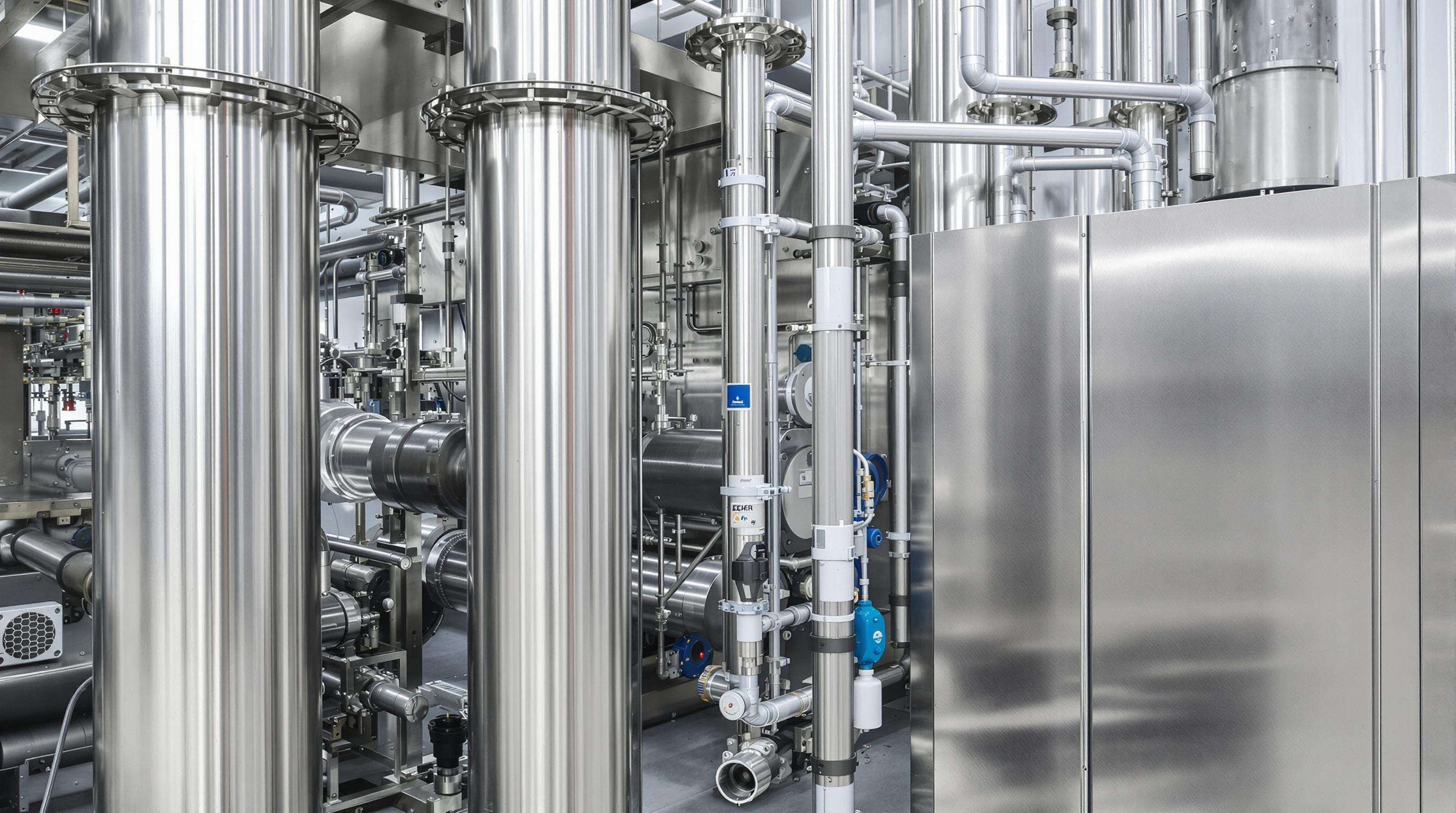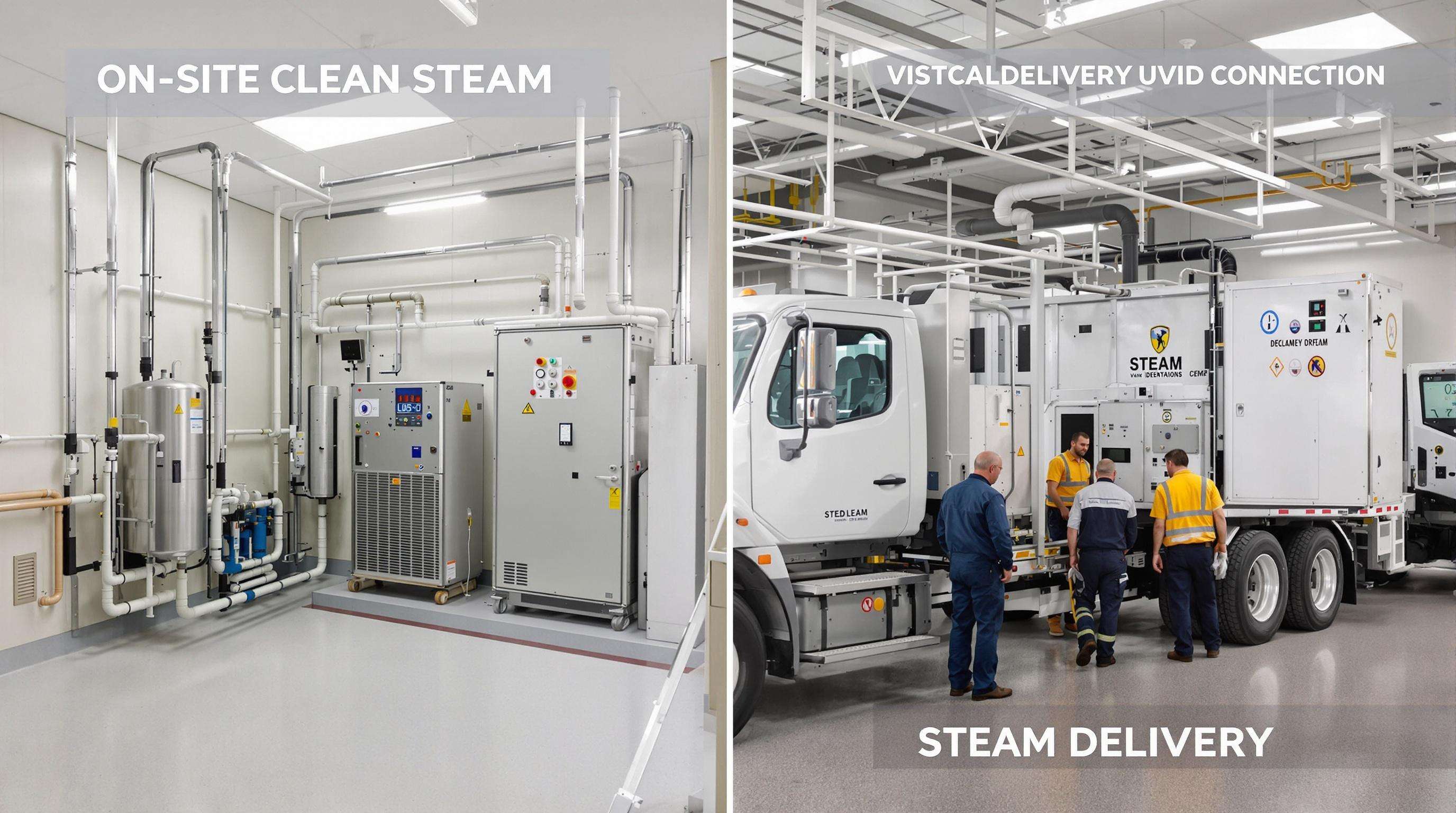การประยุกต์ใช้เครื่องกำเนิดไอน้ำสะอาดสำหรับการทำให้ปลอดเชื้อในสถานพยาบาล
การทำความเข้าใจเทคโนโลยีเครื่องผลิตไอน้ำสะอาดและบทบาทของมันในภาคการดูแลสุขภาพ
เครื่องผลิตไอน้ำสะอาดคืออะไร และมันช่วยสนับสนุนการใช้งานที่ต้องการความบริสุทธิ์สูงได้อย่างไร
เครื่องกำเนิดไอน้ำสะอาดทำงานโดยการเปลี่ยนน้ำที่ผ่านการกรองแล้วให้กลายเป็นไอน้ำ ซึ่งไม่มีสิ่งปนเปื้อนที่ไม่พึงประสงค์อย่างเช่น สารละลายแข็ง สารพิษจากแบคทีเรีย (เอนโดท็อกซิน) หรืออนุภาคสนิม เครื่องเหล่านี้มีบทบาทสำคัญในหลายอุตสาหกรรม เช่น การผลิตยา การทำความสะอาดอุปกรณ์ทางการแพทย์หลังการใช้งาน และภายในเครื่องฆ่าเชื้อด้วยไอน้ำ (Autoclave) ในโรงพยาบาล ซึ่งการฆ่าเชื้ออย่างเหมาะสมมีความสำคัญอย่างยิ่ง สิ่งที่ทำให้เครื่องเหล่านี้แตกต่างจากหม้อน้ำทั่วไปคือ ต้องผ่านกระบวนการบำบัดน้ำป้อนและกลั่นด้วยวิธีการที่ซับซ้อนพอสมควร เพื่อให้ได้มาตรฐานตามข้อกำหนดในบทที่ 1231 ของสหรัฐอเมริกา (USP) สำหรับคุณภาพของไอน้ำ จากการสำรวจล่าสุดที่ดำเนินการในสถานพยาบาลต่าง ๆ ในปี 2024 พบว่า โรงพยาบาลเกือบ 9 ใน 10 แห่งที่เปลี่ยนมาใช้ระบบไอน้ำสะอาดมีความสอดคล้องกับขั้นตอนการฆ่าเชื้อที่ดีขึ้น เมื่อเทียบกับวิธีการเก่าที่เคยใช้ เป็นเรื่องที่เข้าใจได้เมื่อคำนึงถึงความสำคัญของสภาพแวดล้อมที่ปราศจากเชื้อในสถานพยาบาล
ไอน้ำสะอาดกับไอน้ำอุตสาหกรรม: ความแตกต่างหลักในองค์ประกอบและความเหมาะสมสำหรับการใช้งานทางการแพทย์
ไอน้ำอุตสาหกรรมทั่วไปมักจะปะทะกับสารต่าง ๆ ที่ไม่พึงประสงค์ระหว่างกระบวนการผลิต รวมถึงสารเคมี อนุภาคของสนิม และก๊าซที่ไม่สามารถควบแน่นได้ซึ่งรบกวนมาตรฐานความปลอดเชื้อ ตัวเครื่องผลิตไอน้ำสะอาดทำงานแตกต่างออกไป โดยมีการกรองสารปนเปื้อนเหล่านี้ออกได้มากที่สุด ด้วยกระบวนการกรองหลายระดับ รวมถึงการกลั่น ซึ่งทำให้ไอน้ำที่ได้มีคุณภาพสอดคล้องตามข้อกำหนดขององค์การอาหารและยา (FDA) และมาตรฐานยุโรปว่าด้วยเภสัชภัณฑ์ (European Pharmacopoeia) ตัวอย่างเช่น สารพิษจากแบคทีเรีย (Endotoxins) ในไอน้ำสะอาดมีค่าเฉลี่ยประมาณ 0.25 EU ต่อมิลลิลิตร ซึ่งต่ำกว่าค่าเฉลี่ย 10 EU/ml ที่พบได้ในไอน้ำอุตสาหกรรมทั่วไป ความแตกต่างนี้มีความสำคัญอย่างมากเมื่อใช้ในการฆ่าเชื้อวัตถุต่าง ๆ เช่น อุปกรณ์ฝังในร่างกายหรือเครื่องมือแพทย์ที่ต้องการความบริสุทธิ์สูง
องค์ประกอบหลักและหลักการดำเนินงานของเครื่องผลิตไอน้ำสะอาด

เครื่องผลิตไอน้ำสะอาดในปัจจุบันประกอบด้วยสามองค์ประกอบหลัก:
- การกำจัดสิ่งปนเปื้อนในน้ำป้อน : การกรองแบบออสโมซิสย้อนกลับและระบบดีไอโอไนเซชันสามารถกำจัดสิ่งปนเปื้อนได้ถึง 99.9%
- เครื่องแลกเปลี่ยนความร้อน : ผลิตจากเหล็กกล้าไร้สนิมหรือไทเทเนียมเพื่อป้องกันการปนเปื้อนจากโลหะ
- ห้องกลั่น : แยกไอน้ำบริสุทธิ์ออกจากสิ่งปนเปื้อนที่เหลืออยู่
โมเดลขั้นสูงมีเซ็นเซอร์วัดการนำไฟฟ้าและ TOC (Total Organic Carbon) แบบเรียลไทม์ ซึ่งสามารถแจ้งเตือนการบำรุงรักษาเชิงพยากรณ์ งานวิจัยในอุตสาหกรรมแสดงให้เห็นว่า ระบบตรวจสอบเหล่านี้สามารถลดเวลาการหยุดทำงานลงได้ 20–40% โดยการตรวจจับปัญหาก่อนที่จะส่งผลกระทบต่อประสิทธิภาพ
การผนวกรวมระบบไอน้ำสะอาดเข้ากับโครงสร้างพื้นฐานการฆ่าเชื้อในโรงพยาบาล
ปัจจุบันโรงพยาบาลจำนวนมากขึ้นเรื่อยๆ กำลังติดตั้งเครื่องผลิตไอน้ำสะอาดแบบแยกส่วนภายในแผนกจ่ายยาฆ่าเชื้อส่วนกลางและหม้อนึ่งความดันสูงในห้องผ่าตัด การผลิตไอน้ำ ณ สถานที่ปฏิบัติงานช่วยลดการพึ่งพาผู้จัดจำหน่ายภายนอก ซึ่งถือเป็นข้อดีอย่างยิ่ง นอกจากนี้ยังช่วยป้องกันจุลินทรีย์ที่น่ารำคาญเหล่านั้นไม่ให้เข้าสู่ระบบผ่านเส้นทางการจัดจำหน่ายที่ยาวไกล โรงพยาบาลที่เปลี่ยนมาใช้ระบบนี้มักพบว่ากระบวนการตรวจสอบความถูกต้องเร็วขึ้นประมาณ 30% โดยเฉพาะอย่างยิ่งเมื่อนำระบบใหม่เหล่านี้มาปรับใช้กับขั้นตอนการควบคุมคุณภาพในปัจจุบัน ซึ่งสร้างความแตกต่างอย่างแท้จริงสำหรับสถานที่ที่ต้องปฏิบัติตามข้อกำหนด USP <797> สำหรับการผลิตยาปลอดเชื้อ
กระบวนการฆ่าเชื้อด้วยไอน้ำสะอาดในสถานพยาบาล
บทบาทสำคัญของไอน้ำสะอาดในการฆ่าเชื้อด้วยไอน้ำและการควบคุมการติดเชื้อ
การฆ่าเชื้อของเครื่องมือผ่าตัดและอุปกรณ์ทางการแพทย์นั้นขึ้นอยู่กับไอน้ำสะอาดที่ให้ไอน้ำซึ่งปราศจากสารปนเปื้อน เมื่อเราสามารถกำจัดสารพิษจากแบคทีเรีย (endotoxins) รวมทั้งก๊าซที่ไม่สามารถควบแน่นได้ ให้เหลือต่ำกว่า 3% ตามข้อกำหนดใหม่ล่าสุดจากแนวทาง EMA Annex 1 ปี 2023 ก็จะช่วยป้องกันการก่อตัวของชีวฟิล์ม (biofilms) ได้ นอกจากนี้ ไอน้ำยังสามารถเข้าถึงจุดต่าง ๆ ที่ยากต่อการทำความสะอาดตามปกติในอุปกรณ์ที่มีโครงสร้างซับซ้อนอีกด้วย โรงพยาบาลต่างได้รับประโยชน์อย่างชัดเจนหลังจากนำมาตรฐานดังกล่าวมาใช้ การติดเชื้อจากการผ่าตัดลดลงอย่างมากในสถานพยาบาลที่ใช้ระบบไอน้ำสะอาดที่เหมาะสม ซึ่งหมายความถึงผลลัพธ์ที่ดีขึ้นสำหรับผู้ป่วยที่เข้ารับการรักษา
การฆ่าเชื้อด้วยไอน้ำและการกำจัดพิษจากไอน้ำสะอาดที่ใช้ในอุตสาหกรรมยา
เครื่องฆ่าเชื้อแบบอัตโนมัติในปัจจุบันพึ่งพาคุณสมบัติทางความร้อนที่คงที่ของไอน้ำสะอาด เพื่อใช้ในการฆ่าเชื้ออย่างถูกต้องที่อุณหภูมิระหว่าง 121 ถึง 134 องศาเซลเซียส เครื่องเหล่านี้จำเป็นต้องมีเครื่องกำเนิดไอน้ำที่ควบคุมแรงดันได้ เพื่อจัดการกับกระบวนการกำจัดพิโรเจน (depyrogenation) ซึ่งพูดง่าย ๆ คือ การกำจัดพิโรเจนที่ทนความร้อนซึ่งยังคงติดอยู่บนพื้นผิวของหลอดทดลอง (vial) ขณะผลิตยาฉีดเข้าร่างกาย นอกจากนี้ ระบบยังมีการควบคุมความชื้นที่ทำให้ระดับความแห้งของไอน้ำสูงกว่าร้อยละ 95 ซึ่งจะช่วยป้องกันปัญหาที่เรียกกันว่า "wet packs" และในเวลาเดียวกันก็ช่วยให้วัสดุไม่เสียหายและยังสามารถกำจัดจุลินทรีย์ได้อย่างมีประสิทธิภาพ การปรับสมดุลให้ถูกต้องนี้มีความสำคัญอย่างมากต่อมาตรฐานคุณภาพของผลิตภัณฑ์เภสัชกรรม
กรณีศึกษา: การนำระบบเครื่องกำเนิดไอน้ำสะอาดไปใช้ในเครือข่ายโรงพยาบาลขนาดใหญ่ประสบความสำเร็จ
ระบบโรงพยาบาล 12 แห่งสามารถลดความล้มเหลวในการฆ่าเชื้อได้ถึง 40% ภายในระยะเวลา 18 เดือนหลังติดตั้งเครื่องผลิตไอน้ำสะอาดภายในสถานที่ โดยการแทนที่ไอน้ำที่ซื้อมาด้วยไอน้ำบริสุทธิ์ที่ผลิตเอง ทำให้เครือข่ายนี้สามารถลดเวลาที่เครื่องฆ่าเชื้อแบบอัตโนมัติต้องหยุดทำงานในแต่ละปีได้ถึง 83 ชั่วโมง ซึ่งเกิดจากการปนเปื้อนของอนุภาค ผลการตรวจสอบหลังการดำเนินการยืนยันว่าแผนกศัลยกรรมทุกแผนกมีค่าความบริสุทธิ์ของน้ำเป็นไปตามมาตรฐาน USP <1231> เรื่องสารพิษจากแบคทีเรีย (endotoxin) อย่างเต็มที่
การประยุกต์ใช้งานเครื่องผลิตไอน้ำสะอาดในอุตสาหกรรมยาและบริการสุขภาพ
การฆ่าเชื้อเครื่องมือแพทย์และอุปกรณ์เทคโนโลยีชีวภาพโดยใช้ไอน้ำสะอาด
ไอน้ำสะอาดมีความสำคัญอย่างยิ่งต่อการฆ่าเชื้อเครื่องมือผ่าตัด อุปกรณ์ที่ใช้ฝังในร่างกาย และเครื่องปฏิกรณ์ชีวภาพ ด้วยองค์ประกอบที่ปราศจากสารพิษจากแบคทีเรียและสารก่อไข้ ทำให้สามารถฆ่าเชื้อได้อย่างมีประสิทธิภาพที่อุณหภูมิต่ำกว่า 120°C ซึ่งเหมาะสมกับอุปกรณ์ที่ไวต่อความร้อน มากกว่า 78% ของโรงงานผลิตชีวภัณฑ์ที่ได้รับการรับรองจาก FDA ใช้ระบบไอน้ำสะอาดเพื่อให้เป็นไปตามมาตรฐานความบริสุทธิ์ของน้ำตาม USP <1231>
การฆ่าเชื้อวัสดุบรรจุภัณฑ์และภาชนะในกระบวนการผลิตยา
ภายใต้แรงดัน 2–3 บาร์ ไอน้ำสะอาดสามารถฆ่าเชื้อหลอดแก้วและบรรจุภัณฑ์พอลิเมอร์ได้อย่างมีประสิทธิภาพ โดยไม่ทิ้งคราบตกค้างของแร่ธาตุ และสามารถลดจำนวนจุลินทรีย์ได้ถึง 6-log วิธีการนี้สอดคล้องกับแนวทาง GMP สำหรับภาชนะบรรจุยาฉีด และลดความเสี่ยงของสิ่งปนเปื้อนแบบอนุภาคได้มากกว่าการใช้เครื่องฆ่าเชื้อแบบอัตโนมัติทั่วไปถึง 40% (PDA Technical Report 48, 2023)
การใช้งานที่เพิ่มขึ้นในกระบวนการผลิตปลอดเชื้อและสภาพแวดล้อมห้องปฏิบัติการ
ตลาดเครื่องผลิตไอน้ำสะอาดสำหรับการใช้งานในห้องปฏิบัติการทั่วโลกเติบโตขึ้น 12.7% ต่อปีนับตั้งแต่ปี 2021 ซึ่งเป็นผลมาจากความต้องการที่เพิ่มขึ้นในการผลิตวัคซีนและการวิจัยด้านบำบัดด้วยเซลล์ ระบบเหล่านี้สามารถผลิตไอน้ำที่มีความบริสุทธิ์ 99.9% สำหรับห้องสะอาด ISO Class 5 โดยสถานที่ทำการชั้นนำรายงานว่าสามารถฆ่าเชื้อได้เร็วขึ้น 30% เมื่อเทียบกับการใช้ไอน้ำจากโรงงาน
การผลิตไอน้ำภายในสถานที่ vs. การซื้อไอน้ำที่ผ่านการฆ่าเชื้อ: การเปรียบเทียบด้านต้นทุน การควบคุม และการปฏิบัติตามข้อกำหนด

| สาเหตุ | การผลิตภายในสถานที่ | ไอน้ำที่ซื้อมา |
|---|---|---|
| การควบคุมและปฏิบัติตามข้อกำหนด | การตรวจสอบคุณภาพแบบเรียลไทม์ | การพึ่งพาการตรวจสอบจากผู้ขาย |
| ค่าใช้จ่ายในการดำเนินงาน | ประหยัด $18k–$35k/ปี | โมเดลการกำหนดราคาตามปริมาณ |
| การตรวจสอบระบบ | การควบคุมเอกสารอย่างสมบูรณ์ | การรับรองจากบุคคลที่สาม |
โรงพยาบาลที่มีเครื่องกำเนิดไฟฟ้าในสถานที่รายงานว่าความล้มเหลวในการฆ่าเชื้อที่เกี่ยวข้องกับไอน้ำลดลง 58% และประหยัดได้เฉลี่ย $24,000 ต่อสถานที่ต่อปี
มาตรฐานและข้อกำหนดด้านกฎระเบียบสำหรับไอน้ำสะอาดในระบบสาธารณสุข
ข้อกำหนดของ FDA, USP <1231>, และ EP สำหรับความบริสุทธิ์ของไอน้ำในการประยุกต์ใช้ด้านสาธารณสุข
สถานที่ให้บริการทางการแพทย์จำเป็นต้องปฏิบัติตามข้อกำหนดด้านความบริสุทธิ์ที่องค์กรต่างๆ เช่น USP (มาตรา 1231), ยุโรปฟาร์มาโคปเปีย และองค์การอาหารและยา (FDA) กำหนดไว้อย่างเคร่งครัด สำหรับการใช้งานเกี่ยวกับไอน้ำสะอาดนั้นมีข้อกำหนดหลักที่สำคัญหลายประการที่ต้องปฏิบัติตาม ไอน้ำจะต้องมีก๊าซที่ไม่สามารถควบแน่นได้ไม่เกิน 3%, ระดับเอนโดท็อกซิน (Endotoxin) ต้องไม่เกิน 0.25 EU ต่อมิลลิลิตร และค่าการนำไฟฟ้าจะต้องไม่เกิน 1.3 ไมโครซีเมนต์ต่อเซนติเมตร ตามมาตรฐานของยุโรปที่ปรับปรุงล่าสุดในปี 2023 นอกจากนี้ ในเรื่องของข้อบังคับแล้ว แนวทางปฏิบัติการผลิตที่ดีในปัจจุบัน (Current Good Manufacturing Practices) ขององค์การอาหารและยา ยังกำหนดให้ต้องมีการตรวจสอบตลอดกระบวนการฆ่าเชื้อโรคอีกด้วย สิ่งนี้มีความสำคัญมากเพราะจะช่วยป้องกันไม่ให้พิโรเจน (Pyrogens) ปนเปื้อนทั้งอุปกรณ์ทางการแพทย์และผลิตภัณฑ์ยา ซึ่งอาจนำไปสู่ปัญหาด้านความปลอดภัยที่ร้ายแรงตามมาได้
การปฏิบัติตามมาตรฐาน GMP, WHO และ OSHA ด้วยระบบไอน้ำสะอาดที่ได้รับการรับรอง
ระบบไอน้ำสะอาดที่ได้รับการรับรองช่วยสนับสนุนการปฏิบัติตามข้อบังคับต่าง ๆ ผ่านโปรโตคอลอัตโนมัติที่รับประกันว่า:
- GMP : มีข้อมูลคุณภาพของไอน้ำที่สามารถย้อนกลับได้สมบูรณ์ เพื่อเตรียมความพร้อมสำหรับการตรวจสอบ
- WHO : ป้องกันการเกิดไบโอฟิล์ม (biofilm) ในท่อไอน้ำของโรงพยาบาล
- OSHA : มีการออกแบบให้มีวาล์วนิรภัยและออกแบบตามหลักสรีรศาสตร์ เพื่อความปลอดภัยในการบำรุงรักษา
ผลการศึกษาปี 2024 ที่ดำเนินการในโรงพยาบาล 120 แห่ง พบว่า โรงพยาบาลที่ใช้ระบบตรวจสอบแล้ว สามารถลดปัญหาการแปรปรวนในการฆ่าเชื้อได้ถึง 63% เมื่อเทียบกับสถานที่ที่ใช้หม้อน้ำแบบดั้งเดิม
การสร้างสมดุลระหว่างความสอดคล้องตามข้อกำหนดทางกฎหมายกับประสิทธิภาพทางเศรษฐกิจในการดำเนินงาน
แม้ว่าเครื่องกำเนิดไอน้ำสะอาดที่สอดคล้องตามมาตรฐานของสำนักงานคณะกรรมการอาหารและยา (FDA) จะต้องลงทุนเริ่มต้นสูงกว่า 12–18% แต่ก็ให้ต้นทุนตลอดอายุการใช้งานที่ต่ำกว่าถึง 22% เนื่องจาก:
- ทดสอบความบริสุทธิ์โดยอัตโนมัติ ช่วยประหยัดเวลาแรงงานได้ 240 ชั่วโมงต่อปี
- ลดความถี่ในการทำความสะอาดด้วยสารเคมี จากทุกสัปดาห์เป็นทุกไตรมาส
- อุปกรณ์ที่เกี่ยวข้องกับไอน้ำเสียหายลดลงถึง 40% (Ponemon 2023)
ระบบไฮบริดในปัจจุบันช่วยให้โรงพยาบาลสามารถใช้ไอน้ำเกรด USP ในช่วงเวลาที่ต้องการฆ่าเชื้อสูงสุด และเปลี่ยนไปใช้ไอน้ำเกรดต่ำกว่าสำหรับการให้ความร้อนในช่วงเวลาที่ไม่ใช่ช่วงเร่งด่วน ทำให้ประหยัดพลังงานได้ 31% โดยไม่กระทบต่อความสอดคล้องตามข้อกำหนด
ข้อดีของเครื่องผลิตไอน้ำสะอาดในการทำให้ปราศจากเชื้อในโรงพยาบาลสมัยใหม่
การรับประกันความปลอดภัยของผู้ป่วยผ่านกระบวนการการทำให้ปราศจากเชื้อที่ไม่มีการปนเปื้อน
เครื่องผลิตไอน้ำที่ออกแบบมาเพื่อการใช้งานที่สะอาดสร้างไอน้ำที่เป็นไปตามมาตรฐานทางเภสัชกรรม โดยพื้นฐานปราศจากสารพิษจากแบคทีเรีย (Endotoxins) แร่ธาตุ และสารปนเปื้อนอินทรีย์ที่ก่อให้เกิดปัญหาต่าง ๆ ระบบนี้สามารถตอบสนองข้อกำหนดที่ปรับปรุงใหม่ตามแนวทาง Annex 1 ปี 2023 ของสำนักงานยาแห่งยุโรป (European Medicines Agency) ซึ่งกำหนดให้ความบริสุทธิ์ของไอน้ำต้องมีระดับต่ำกว่า 0.25 EU ต่อมิลลิลิตร เมื่อโรงพยาบาลเปลี่ยนจากการใช้หม้อน้ำแบบดั้งเดิมที่มีสารเติมแต่งและไอออนโลหะลอยอยู่ภายใน พวกเขามักจะพบว่าการสะสมของสารชีวภาพ (Biofilm) ในเครื่องฆ่าเชื้อแบบอัตโนมัติ (Autoclaves) ลดลงอย่างชัดเจน จากการศึกษาพบว่าระบบสะอาดเหล่านี้สามารถลดการสะสมของ Biofilm ได้ประมาณร้อยละ 78 เมื่อเทียบกับระบบทั่วไป และสิ่งนี้มีความสำคัญมาก เนื่องจากช่วยลดจำนวนการติดเชื้อหลังการผ่าตัด ซึ่งเป็นสิ่งที่ไม่มีใครอยากพบเจอในบริบทของการดูแลสุขภาพ
ประสิทธิภาพด้านพลังงาน ความน่าเชื่อถือ และการบำรุงรักษาที่ต่ำของเทคโนโลยีไอน้ำสะอาดขั้นสูง
ระบบสมัยใหม่สามารถกู้คืนพลังงานความร้อนแฝงได้ถึง 92% ผ่านการออกแบบระบบปิด ซึ่งช่วยลดการใช้พลังงานลง 35% เมื่อเทียบกับหม้อน้ำแบบดั้งเดิม ระบบการบำรุงรักษาเชิงทำนายสามารถตรวจจับความจำเป็นในการเปลี่ยนตัวกรองและล้างตะกรันล่วงหน้าได้สูงสุดถึง 30 วัน ช่วยลดการหยุดทำงานที่ไม่ได้วางแผนไว้ลงถึง 80% ระบบควบคุมแบบ Solid-state ช่วยรักษากดดันให้แม่นยำ (±0.2 บาร์) และความแห้งของไอน้ำ (>97%) ซึ่งยืดอายุการใช้งานของชิ้นส่วนให้ยาวนานเกินกว่า 15,000 ชั่วโมงการทำงาน
ผลกระทบที่วัดได้: ลดการปนเปื้อนของจุลินทรีย์ลง 40% หลังการนำไปใช้
การศึกษาในปี 2023 ที่ดำเนินการใน 47 โรงพยาบาล พบว่าการใช้ไอน้ำสะอาดช่วยลดการแจ้งเตือนการปนเปื้อนที่เกี่ยวข้องกับการฆ่าเชื้อลงได้ 40% ภายในระยะเวลา 12 เดือนหลังการใช้งาน การปรับปรุงนี้ช่วยให้สถานพยาบาลสามารถนำถาดเครื่องมือผ่าตัดมาใช้ใหม่ได้เพิ่มขึ้น 22% ต่อวัน ขณะเดียวกันก็ลดความถี่ของการทดสอบตรวจสอบลงครึ่งหนึ่ง ส่งผลให้ประหยัดค่าใช้จ่ายด้านความสอดคล้องลงได้ถึงปีละ 480,000 ดอลลาร์สหรัฐต่อโรงพยาบาลที่มีจำนวนเตียง 300 เตียง
ส่วน FAQ
ไอน้ำสะอาดคืออะไร และเหตุใดจึงมีความสำคัญในภาคการดูแลสุขภาพ?
ไอน้ำสะอาดคือไอน้ำที่ผ่านการกลั่นและกรองอย่างเข้มงวดจากน้ำที่ผ่านกระบวนการบำบัดแล้ว ไอน้ำชนิดนี้ปราศจากสารปนเปื้อน เช่น แอนโดท็อกซิน (Endotoxins) ซึ่งมีความสำคัญอย่างยิ่งต่อกระบวนการฆ่าเชื้อในสถานพยาบาล เพื่อให้มั่นใจว่าอุปกรณ์และสภาพแวดล้อมทางการแพทย์มีความสะอาดปราศจากเชื้อ
เครื่องผลิตไอน้ำสะอาดแตกต่างจากหม้อน้ำทั่วไปอย่างไร?
เครื่องผลิตไอน้ำสะอาดใช้เทคโนโลยีการบำบัดน้ำป้อนและกระบวนการกลั่นขั้นสูง เพื่อผลิตไอน้ำที่ปราศจากสิ่งเจือปน ต่างจากหม้อน้ำทั่วไป เครื่องเหล่านี้ถูกออกแบบมาเพื่อให้เป็นไปตามมาตรฐานคุณภาพไอน้ำที่เข้มงวด โดยเฉพาะสำหรับการใช้งานทางการแพทย์และเภสัชกรรม
องค์ประกอบหลักของเครื่องผลิตไอน้ำสะอาดคืออะไร?
องค์ประกอบหลักได้แก่ ระบบบำบัดน้ำป้อน ชุดเปลี่ยนถ่ายความร้อน และห้องกลั่น ระบบขั้นสูงอาจมีเซ็นเซอร์แบบเรียลไทม์สำหรับการบำรุงรักษาเชิงพยากรณ์
อุตสาหกรรมใดบ้างที่ได้รับประโยชน์สูงสุดจากการใช้ไอน้ำสะอาด?
ไอน้ำสะอาดมีประโยชน์ต่ออุตสาหกรรมต่างๆ เช่น ด้านการดูแลสุขภาพ ยา และเทคโนโลยีชีวภาพ ซึ่งต้องการไอน้ำที่มีความบริสุทธิ์สูงสำหรับการฆ่าเชื้ออุปกรณ์และกระบวนการทำงานผลิต
ไอน้ำสะอาดช่วยควบคุมการติดเชื้อในโรงพยาบาลได้อย่างไร?
ไอน้ำสะอาดช่วยในการฆ่าเชื้อได้อย่างมีประสิทธิภาพ ลดการปนเปื้อนและสารเคลือบชีวภาพ จึงช่วยลดการติดเชื้อหลังการผ่าตัด และเพิ่มประสิทธิภาพในการรักษาผู้ป่วย

 EN
EN







































